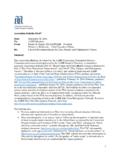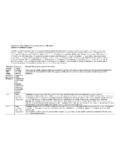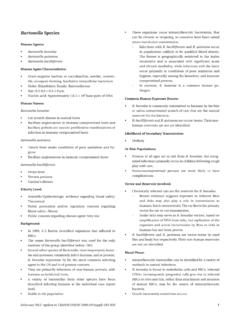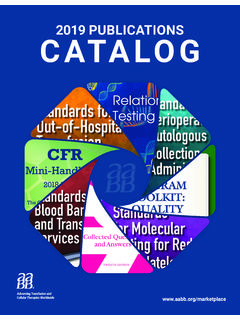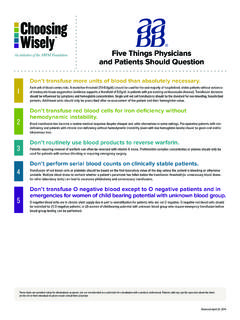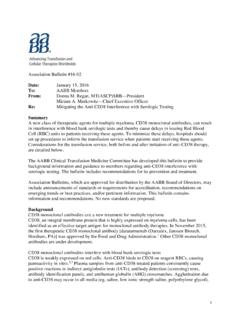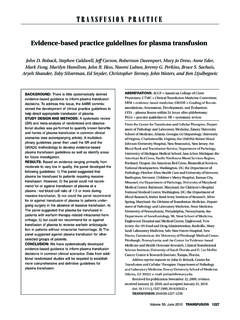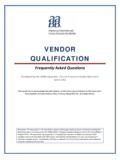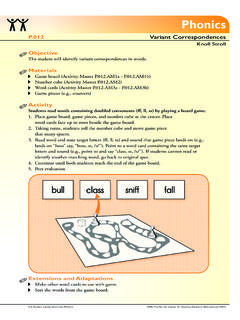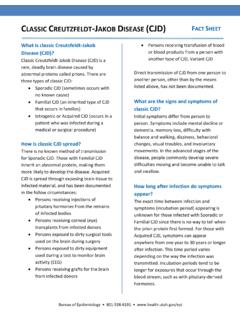Transcription of Variant Creutzfeldt Jakob Disease (vCJD) - AABB
1 Variant Creutzfeldt Jakob Disease (vCJD) Disease Agent: Variant Creutzfeldt Jakob Disease prion (vCJD prion) Disease Agent Characteristics: Current evidence supports the theory that the infec-tious agent is a prion. However, the existence ofaccessory factors has not been excluded. Prions are considered members of the transmissiblespongiform encephalopathy (TSE) group of agentsthat include kuru, Creutzfeldt Jakob Disease (CJD),and Variant CJD (vCJD); CJD is discussed in a separatefact sheet. Prion diseases are either sporadic, inher-ited, or infectious.
2 Prions are the agent, whetherheritable through a germline mutation in the humangene,PRNP, or infectious. Prions are infectious proteins that are devoid ofnucleic acid that result in certain disorders throughbinding and accumulation of the abnormal Disease -causing prion isoform to the normal prion protein. Mammalian prions replicate by recruiting the normalcellular isoform of the prion protein PrPCto form adisease-causing isoform designated the designations for the pathogenic formsand are used interchangeably in the literature.
3 Prions are nonimmunogenic because of the sharingof epitopes with the normal cellular isoform. PrPCis soluble and circulates in plasma, is alsopresent on many cell membranes, and has a molecu-lar weight of about 33-35 kDa. PrPSchas a more restricted tissue range than doesPrPC. Prion diseases represent disorders of protein confor-mation in which the tertiary structure of the pre-cursor protein is profoundly altered. The transitionoccurs when theahelical protein of PrPCchanges intoab-sheet-rich molecule of PrPresisfolded into a form containing 50%bsheet and is resis-tant to proteases (proteinase K, lysosomal enzymes).
4 PrPSccan form aggregates that precipitate as amy-loid plaques in the CNS; these are a histopatho-logical hallmark of the transmissible spongiformencephalopathies. Physicochemical properties: Resistance of prions tocommonly used disinfectants (formaldehyde, glut-araldehyde, ethanol, and iodine) is well in undiluted bleach (60,000 ppm or mg/Lof available chlorine) for 1 hour is only partially effec-tive. Prions are resistant to ultraviolet light and ioniz-ing radiation, ultrasonication, nucleases, boiling, andheat. High concentrations of NaOH (1-2 N) and pro-longed autoclaving (1-5 h) at high temperatures (120-135 C) are advocated for Name: Variant Creutzfeldt Jakob Disease (vCJD) Human transmissible spongiform encephalopathyPriority Level: Safety/Epidemiologicevidenceregardingblo odsafety: Low: Due to the absence of endogenoushuman infection in North America and the possibleimpact of stringent deferral policy.
5 There is strong evi-dence for transfusion transmission in the UK. Public perception and/or regulatory concern regard-ing blood safety: High Public concern regarding Disease agent: ModerateBackground: Emergent; first occurred in UK in 1994; recognized asa distinct Disease in 1996 As of Oct 2008, 206 cases and 203 deaths have occurred in the UK or after alleged dietaryexposure to exported UK beef products elsewhere. The average age of vCJD patients is 26 years (range:12-74 years) in contrast to CJD. The increased preva-lence of vCJD in teenagers and young adults relativeto older age groups remains an enigma.
6 Human PrP is encoded by a gene (PRNP) located onchromosome 20. A methionine/valine polymorphismat codon 129 appears to influence the expression ofvCJD because all patients with vCJD are homozygousfor methionine. It is postulated that vCJD resulted from the transmis-sion of bovine spongiform encephalopathy (BSE) tohumans. BSE has an incubation time of approxi-mately 5 years and is apparently caused by thefeeding of meat and bone meal (MBM) to dairy MBM was prepared from the offal of sheep, cattle,pigs, and chickens. Changes in the rendering of offalin the late 1970s may have permitted prions to survivethis process and initiate the epidemic.
7 In 1988, theprocess of feeding offal to cattle was banned, leadingto a waning of the bovine Human Exposure Routes: Consumption of beef products containing neuraltissue from cattle infected with BSE prionsLikelihood of Secondary Transmission: By analogy with CJD, tissues and surgical instrumentsmay pose a risk of secondary transmission. Blood has been demonstrated to transmit the Populations: Individuals who ingest beef products (containingneural tissue) from animals infected with BSEAPPENDIX 252S TRANSFUSIONV olume 49, August 2009 Supplement Individuals who receive blood transfusions in areasconsidered at increased risk of vCJD ( , UK andFrance) Individuals who are exposed to surgical instrumentspreviously used on patients with vCJD Genetic predisposition.
8 All vCJD patients studied todate (dietary and transfusion exposures) have beenhomozygous for methionine on codon 129 of PrPexcept for one transfused patient who (methionine/valine) on codon 129 of PrP and died of anonneurologic Disease with no clinical evidence ofvCJD. vCJD prions were found in the spleen and acervical lymph node but not in the brain of and Reservoir Involved: No vector Humans and cattle serve as a Phase: Identified in experimentally infected animal modelsprior to development of clinical Disease Unlike CJD in humans, there is widespread replica-tion of the prion protein and deposition of PrPScinlymphoreticular tissues, such as tonsils, spleen, andlymph nodes.
9 Lymphocytes traffic freely betweenblood and lymphoid tissues, probably contributing tothe observed infectivity of in Blood Products: Unknown, but likely will survive for entire storageperiod by extension from known physicochemicalproperties of by Blood Transfusion: Documented experimentally in sheep for BSE (36% ofexposed recipients). Transmissions occurred fromdonor animals at 50% of the estimated incubationperiod. Also documented for scrapie (43%) in thesame experimental system. Relatively high rates of transmission by blood trans-fusion in humans: Documented transfusion transmission to fourrecipients of nonleukoreduced RBCs; three haddisease while one had prions in tissue, but nodisease.
10 These were part of an ongoing study of66 recipients followed after receiving labile bloodcomponents from 18 donors who subsequentlydeveloped vCJD. The four recipients of the recipients surviving longer than 5years. The three recipients who developed vCJDshowed symptoms at years. These four cases arose from three asymptomaticdonors who subsequently developed clinicalvCJD between 17 and 42 months after donation. An elderly hemophiliac in the UK was found to haveevidence of infection with the vCJD prion, only in hisspleen, at postmortem; the cause of death was unre-lated to vCJD.

